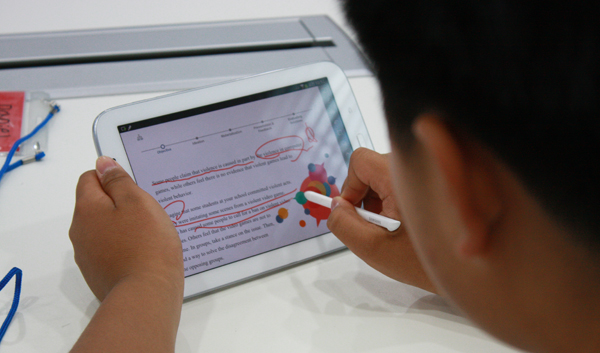Devices show promise in classrooms

A student uses a tablet PC to follow a lecture at a private institute in southern Seoul. Provided by Chung Dahm Learning
A teacher has connected a tablet computer to a video projector, connecting to a streaming video on the Internet to draw, highlight and interact with what is on the students’ screens. With conferencing services and the newest wireless video systems, students can share their screens with the instructor and the entire class.
Gyeseong is one of 144 pilot schools designated by the Ministry of Education to bring cutting-edge technology to learning and teaching.
Tapping into its advanced IT technology, Korea wants to make the best use of it for the education that is highly valued in this society with Confucian roots. If the pilot project succeeds, Gyeseong will be one of 450 primary, middle and high schools nationwide that will be connected to tablet-based digital textbooks next year as part of a technology integration drive.
The education ministry says it will look at the results of the larger test of this technology before deciding whether to make digital textbooks the norm for all schools.
Some institutes and schools that have already adopted digital gadgets as a new tool offer a glimpse of the future. Cho Gi-seong, a teacher at the Gyeseong Elementary School, painted an optimistic picture after using the tablets for a year.
“I found that my students, especially the distracted, disorganized boys, have become more focused in class after introducing the digital devices,” he said.
But the digital charms were so strong at first that a few students were actually distracted by them. “At first, they tried to play computer games or do other entertaining things while I taught them. But there is a monitoring device that allows teachers to follow what students are actually doing on their gadgets,” he said, adding that students’ concentrations improved gradually as they became accustomed to the new tools.
Experts suggest that discussions about the new technology should be geared to how, rather than whether, to take advantage of it. Most believe that adoption of some type of digital learning is inevitable.
“We need to take the bull by the horns,” said Kim Jin-sook, the director of the smart education division at the Korea Education and Research Information Service, a government organization set up to do research on Internet-based learning systems.
“Many of the younger generation feel more comfortable with acquiring knowledge through digital gadgets than from textbooks and publications,” Kim said. “So we need to adapt to the changing trends, rather than only highlighting bad side effects.”
In addition to the way that digital media can engage young learners, Kim added, the incorporation of high-tech teaching methods will help teachers better track student performance and ensure up-to-date content - all while saving money over the longer term.
Kwak Geum-ju, a psychology professor at Seoul National University, echoed Kim’s view. “Children are tempted to do things that parents and teachers ask them not to. We need to teach children how to control their desires,” the professor said.
“Teachers and students can make rules together, which will enhance engagement between them. We need to acknowledge that digital gadgets are highly addictive, but the educational functions of the devices might reduce the harmful effects,” Kwak said.
A Keris study found that all 14 schools that were early adopters of the advanced digital devices reported improvement in peer-to-peer cooperation, creativity, concentration and communication skills.
Cho, the elementary school teacher, testified to the positive effects on students’ communication skills and creativity.
“Many students began sharing their daily life, class feedback and trouble in learning through social networking sites, something that they rarely did before,” he said. “As they have more options to acquire knowledge through gadgets, I found students to be more creative and active.”
Kwak underlined the boost in engagement that electronics drew from reserved, shy students who rarely participated in class. “Quiet, passive students are unlikely to ask questions by raising hands or coming forward in a traditional classroom setting,” the psychologist said.
BY HONG JOO-HEE [ejpark@joongang.co.kr]










with the Korea JoongAng Daily
To write comments, please log in to one of the accounts.
Standards Board Policy (0/250자)